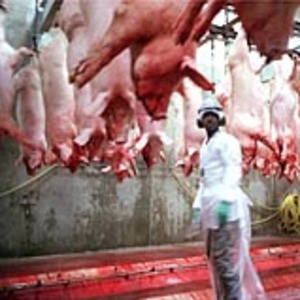Byline: Charlie LeDuff; 2000-06-18; The New York Times;
Report: Undercover Along the Food Chain
Tags: Charlie LeDuff, meat, race, slaughterhouse, worked as
Article LinksIt must have been 1 o'clock. That's when the white man usually comes out of his glass office and stands on the scaffolding above the factory floor. He stood with his palms on the rails, his elbows out. He looked like a tower guard up there or a border patrol agent. He stood with his head cocked.One o'clock means it is getting near the end of the workday. Quota has to be met and the workload doubles. The conveyor belt always overflows with meat around 1 o'clock. So the workers double their pace, hacking pork from shoulder bones with a driven single-mindedness. They stare blankly, like mules in wooden blinders, as the butchered slabs pass by.It is called the picnic line: 18 workers lined up on both sides of a belt, carving meat from bone. Up to 16 million shoulders a year come down that line here at the Smithfield Packing Co., the largest pork production plant in the world. That works out to about 32,000 a shift, 63 a minute, one every 17 seconds for each worker for eight and a half hours a day. The first time you stare down at that belt you know your body is going to give in way before the machine ever will.
Description:This piece was part of the New York Times "How Race Is Lived" series of 2000, which won the 2001 Pulitzer Prize for National Reporting. It was the only piece in the series in which the reporter took a job without disclosure to his employers of his actual intentions.
Rights: provided as links to online material from other sources
